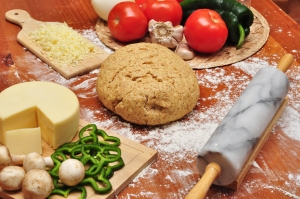Italian cuisine: A recipe for good health
Italian cuisine: A recipe for good health
Italian cuisine: A recipe for good health
-
Hannah
-
Hannah
Cooking is one of my passions in life – particularly making dishes using fresh, home-grown or locally sourced ingredients. When I am in France one of my favourite pastimes is wandering around local markets and stacking my basket high with breads, meats, cheeses, fish and fruits and vegetables, and in Kent my kitchen garden supplies all manner of ingredients for the dinner parties I regularly host.
Though I grew up in Egypt, and now live in France and Kent in England, I am decidedly international in my approach to dining and cooking – I love to try recipes from all the world’s cuisines, and I quite often throw ‘World Food’ parties at which I serve a particular country’s specialties. My new novel, The Echoes of Love, is set in Italy, which provided the perfect excuse for me to get stuck into some Italian cooking – delicious!
The typical Italian daily diet is as follows:
- Breakfast (colazione): Coffee (often a frothy sort) or hot chocolate with bread, rolls, pastries, biscotti and jam. Sometimes, cereal and yoghurt.
- Lunch (pranzo): The big meal of the day, taken somewhere between midday and two p.m. Lunches are, by tradition, leisurely, although the faster pace of work days squeezes the lunch period for some. To start, antipasto, which may comprise breads, cold meats, cheeses, olives, crudités and dips. Then comes a first course – pasta, risotto or soup – followed by a second course of meat or fish with vegetables. To finish, a traditional desert, if you can manage it, or some fruit.
- Dinner (cena): Similar to the lunch menu, but much lighter – could be salad, soup or leftovers from earlier. Most people eat between half past seven and nine p.m.
The arrangement of meals plays a part in healthy digestion. Experts agree that you should consume most of your calories at lunchtime, so that you burn them off with activity in the afternoon.
And what of the cuisine itself? The Mediterranean diet, of which Italian cuisine is a major part, is well known for its health benefits. According to the Mayo Clinic, ‘Research has shown that the traditional Mediterranean diet reduces the risk of heart disease. In fact, an analysis of more than 1.5 million healthy adults demonstrated that following a Mediterranean diet was associated with a reduced risk of death from heart disease and cancer, as well as a reduced incidence of Parkinson’s and Alzheimer’s diseases.’
InItaly, the Mediterranean diet is especially linked to simplicity. Many Italian dishes have only four to eight ingredients. That means ingredients really matter – the better their quality, the tastier and more healthy the food. So if, like me, you love Italian food, here are some staple ingredients that are high on the ‘good for you’ list. Seek out the very best you can find for the most authentic, delicious taste!
- Carbohydrates: The Italians don’t shy away from carbs; their diet is rich in breads, pastas and rice (risotto), all of which provide slow-release energy to stop you snacking and, in wholegrain form, have a host of health benefits.
- Tomatoes: Vitamin C, Vitamin A, potassium, folate and lycopene (which helps your heart stay healthy and fights off some cancers) – all of these are in the simple tomato. A basic tomato sauce appears in many Italian recipes.
- Olive oil: Experts recommend you use this oil for just about all your cooking, and instead of butter. It’s ideal for salad dressings and for sautéing vegetables.
- Garlic: The French are perhaps better known for their use of garlic in cooking, but it remains an ingredient in many simple Italian dishes too. Like the tomato, garlic is ideal for cancer prevention and heart health.
- Fish: The benefits of a diet rich in fish are well documented. Being surrounded by sea on three sides, Italians very much embrace the rich offerings of the ocean.
- Nuts: Monounsaturated fat (good for the heart), protein, fibre, Vitamin E, folate, calcium and magnesium… all in a handful of nuts. Pine nuts are a favourite – try making your own pesto with these at home.
- Cheese: Cheese gets a bad press for being fattening, and in large quantities it is. But when it comes to flavourful Italian cheeses, a little goes a long way – and, essentially, a little fat is required in a healthy diet. Parmesan and Grana Padano are firm favourites, as are the soft varieties like mascarpone and ricotta.
You’ll find these ingredients, and others, in the dishes my characters eat in The Echoes of Love, and over the coming months I will post the odd recipe of a dish from the book for you to try at home. Buon appetito!

That recipe sounds amazing Hannah. Have you ever been to Santa Monica? There’s a delicious italian restaurant there called Via Veneto that is to die for. Just sharing the info…being an italian foodie an all. : )
Thanks, Antony.